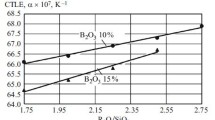Abstract
The results of studies of the electrophysical and thermophysical characteristics of borosilicate glass designed to attenuate electromagnetic radiation in the microwave range are presented. The compositions of glass with the minimal tendency to crystallization are determined. The effect of the chemical composition of glass on its thermophysical (temperature coefficient of linear expansion (TCLE) and heat capacity) and electrophysical (attenuation index, standing wave ratio, and dielectric loss tangent) properties is found. The proposed glass compositions can be recommended for the manufacturing of products used as shielding against radiation.








Similar content being viewed by others
REFERENCES
Martsul’, V.N., Kaporikov, V.P., and Golovach, A.M., Ekologiya i kontrol’ sostoyaniya okruzhayushchei sredy (Ecology and Environmental Control), Minsk: Beloruss. Gos. Tekh. Univ., 2009.
Slukin, V.M., Technogenic radiations as a factor in ecology human spaces, Akad. Vestn. UralNIIproekt RAASN, 2010, no. 4, pp. 120–124.
Rezchikov, E.A., Tkachenko, Yu.L., and Ryazantseva, A.V., Bezopasnost’ zhiznedeyatel’nosti (Life Safety), Moscow: Mosk. Gos. Ind. Univ., 2006.
Ryabokon’, I.Yu., Development of elements of the system of protection against microwave radiation of the personnel of the radio engineering complex using radio-absorbing materials, Extended Abstract of Cand. Sci. Dissertation, Sevastopol, 1990.
Dyadenko, M.V., Lyubetskii, N.V., Karpovich, V.A., and Petukhovskaya, A.G., Vitreous materials with different complex of electrophysical characteristics, Elektron. Tekh., Ser. 1: SVCh Tekh., 2018, no. 1 (536), pp. 52–59.
Elizarov, A.S., Elektroradioizmereniya (Electroradio Measurements), Minsk: Vysheish. Shkola, 1986.
Papko, L.F. and Kravchuk, A.P., Fiziko-khimicheskie metody issledovaniya neorganicheskikh veshchestv i materialov (Physicochemical Methods for the Study of Inorganic Substances and Materials), Minsk: Beloruss. Gos. Tekh. Univ., 2019.
Bobkova, N.M. and Papko, L.F., Khimicheskaya tekhnologiya stekla i sitallov (Chemical Technology of Glass and Sitalls), Minsk: Beloruss. Gos. Tekh. Univ., 2005.
Appen, A.A., Khimiya stekla (Chemistry of Glass), Moscow: Khimiya, 1974.
Kabardin, O.F., Fizika: spravochnye materialy (Physics References), Moscow: Prosveshchenie, 1991.
Mashkovich, V.P., Zashchita ot ioniziruyushchikh izluchenii (Protection against Ionizing Radiation), Minsk: Energoatomizdat, 1995.
Tugov, I.I. and Kostrykina, G.I., Khimiya i fizika polimerov (Chemistry and Physics of Polymers), Moscow: Khimiya, 1989.
Stevels, J.M., The Electrical Properties of Glass, in Electrical Conductivity II, vol. 4 of Encyclopedia of Physics, Heidelberg: Springer, 1957.
Tomilin, V.I., Tomilina, N.P., and Bakhtina, V.A., Fizicheskoe materialovedenie (Physical Materials Science), Krasnoyarsk: Sib. Fed. Univ., 2012, vol. 1.
Negodenko, O.N. and Miroshnichenko, S.P., Materialy elektronnoi tekhniki (Electronic Engineering Materials), Taganrog: Taganrog. Radiotekh. Univ., 2006.
El-Egil, K., Infrared studies of Na2O–B2O3–SiO2 and Al2O3–Na2O–B2O3–SiO2 glasses, Phys. B (Amsterdam, Neth.), 2003, vol. 325, pp. 340–348.
Balachandera, L., Ramadevudub, G., Shareefuddina, Md., Sayannac, R., and Venudharc, Y.C., IR analysis of borate glasses containing three alkali oxides, Sci. Asia, 2013, vol. 39, pp. 278–283.
Konijnendijk, W.L., The Structure of Borosilicate Glasses, Eindhoven: Univ. Technol., 1975.
Manara, D., Grandjean, A., and Neuville, D.R., Advances in understanding the structure of borosilicate glasses: A Raman spectroscopy study, Am. Mineralog., 2009, vol. 94, pp. 777–784.
Osipov, A.A., Osipova, L.M., and Bykov, V.N., Spektroskopiya i struktura shchelochnoboratnykh stekol i rasplavov (Spectroscopy and Structure of Alkaline Borate Glasses and Melts), Yekaterinburg, Miass: Ural. Otd. Ross. Akad. Nauk, 2009.
Author information
Authors and Affiliations
Corresponding author
Ethics declarations
The authors declare that they have no conflict of interest.
Additional information
Translated by G. Levit
Rights and permissions
About this article
Cite this article
Dyadenko, M.V., Trusova, E.E. & Sidorevich, A.G. Borosilicate Radiation Shielding Glass. Glass Phys Chem 47, 30–37 (2021). https://doi.org/10.1134/S1087659621010041
Received:
Revised:
Accepted:
Published:
Issue Date:
DOI: https://doi.org/10.1134/S1087659621010041




